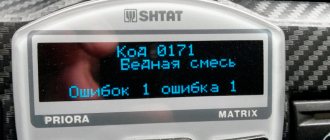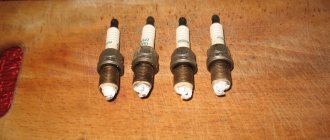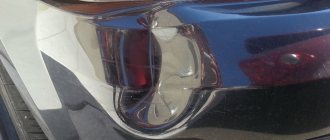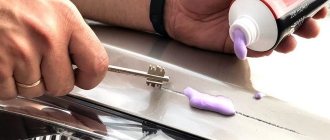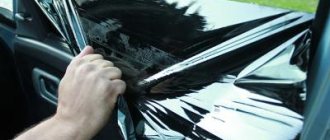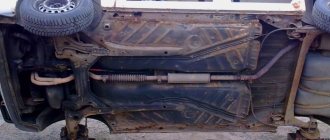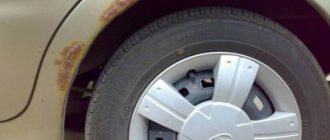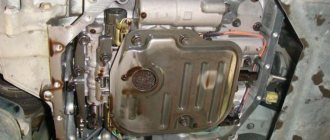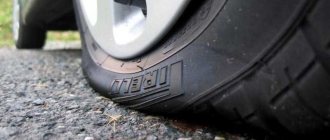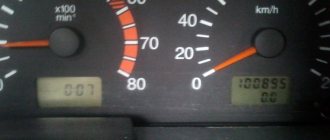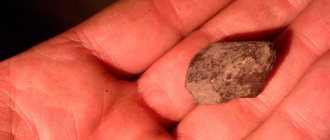Home ● Repair of lateral cuts and hernias
A modern tire is a complex, multi-layer product consisting of several parts:
- frame - responsible for mechanical strength;
- bead ring – provides shape and rigidity;
- beads – used to secure the tire to the rim;
- breaker – protects the top of the frame from impacts and through damage;
- elastic sidewall – protects the side surfaces of the frame;
- filling cord – enhances the ring-sidewall transition;
- tread – provides traction between the wheel and the road surface.
Due to the design features, tire repair technology depends on the location, nature and extent of damage. Let us list the most typical defects.
- Tire (wheel) puncture. This is a minor damage (usually caused by a nail or screw) that has caused the tire to lose its seal. Since the cord in the frame or belt is slightly damaged in this case, wheel repair is possible in 100% of cases.
- Tire (wheel) cut. More serious damage (broken glass, large metal object), leading not only to loss of tightness, but also to breakage of cord threads. Repair of tire cuts is also possible in most cases, with the exception of large side cuts of radial tires, since this is associated with significant weakening of the load-bearing structure.
- Bulging of the tire (hernia). Popularly, this injury is also called a “hernia.” Bloating usually occurs due to the wheel falling into a hole at speed or the wheel hitting a curb. As a result, the outer rubber layer peels off from the cord or the fibers (cord) in the frame rupture. A hernia is dangerous because it can burst at any second with subsequent loss of control. Repairing such tires is acceptable if the number of damaged fibers is not too large.
- Geometry distortion. Occurs in case of serious overloads, a factory defect or incorrect tire fitting work. It can manifest itself in the form of a change in the shape of the running surface (hernia and figure eight), cord fibers coming out, deformation of the bead ring, and so on. Most often, it is impossible to restore the original geometry - the tire (wheel) needs to be replaced.
Causes of hernia
Visually, this defect manifests itself as a bulge on a car wheel, but what is the reason for the appearance of such a tumor?
Studies of damaged tires have shown that behind any such bump there is a rupture of the metal cord and textile bandage, which keep the shape of the inflated tire. Rubber deprived of reinforcement inflates like a balloon, forming a knob-like growth in the area of the bead or contact pad. What can trigger the occurrence of such a growth? The list of reasons for the appearance of a rubber bump includes:
- Violations of production technology - defects in cord winding result in the appearance of a hernia in the first year of tire operation.
- Hitting any obstacle at high speed - in this case, contact between the wheel rim and the inner surface of the tire is possible, after which even the strongest cord will burst.
- Side cut - a weakened cord or band cannot contain the internal pressure, because even a passenger tire is inflated to 2.0-2.5 bar.
If the first reason should be left to the conscience of the manufacturer, then in other cases the occurrence of a hernia is provoked by the driver himself. Hitting a pothole at full speed, hitting a curb, an accident, bad parking—the list goes on and on. Therefore, careless car owners prefer not to notice the damage to the wheel, continuing to drive on a swollen tire. Of course, this does not lead to anything good.
How does a hernia appear on the wheel?
A bulge (bubble) on the sidewall indicates that the tire belt has been cut and the internal structure is damaged.
Unfortunately, in most cases, such a tire cannot be restored and is no longer suitable for further use.
First of all, such a wheel cannot be balanced. With a higher load it can be fired.
rice. Hitting a curb or hole is one of the main causes of hernias.
The main reasons for the appearance of bulges on the sidewall include:
- defective rubber;
- hitting a hole or pothole;
- hitting a curb;
- Road accident.
Sometimes minor defects in the sidewall - abrasions - may be observed on the surface of the tire.
It is very rare to see indentations on the sidewall of a tire. Unlike bulges, they are not dangerous. This is more of an “innate” feature of the tire than a defect, and does not threaten its further use.
The second group of splint injuries are those associated with the splint's forehead. Here we most often deal with punctures or uneven, unnatural tread wear.
Why can't you drive with a hernia?
Is it possible to ride with cord damage and swelling on the beads or contact surface? Of course no! After all, even a sharp stone thrown from under the wheels of a neighboring car can pierce a rubber bump. And then your tire will not just deflate, but burst like a balloon. But before this happens, an advanced hernia will lead to:
- to increased pressure in the wheel and problems with handling - the car will lose directional stability;
- to overheating and rapid wear of the tread - after this the tire will go to a landfill, because only some truck tires can repair worn out treads;
- to the destruction of the hub, bearing and suspension of the car - they will be destroyed by the radial and axial runout of the wheel rim.
Therefore, all experienced drivers know what to do if a tire herniation occurs at the beginning or end of the journey. In this case, you need to slow down, park to the side of the road, replace the wheel, deflate the damaged tire and go to a car service center or the nearest auto store. After all, the danger of an accident outweighs the consequences of any delay on the road.
If stopping is impossible for some reason, for example, due to the lack of a spare wheel, disembark the passengers, slow down to 20-30 km/h, drive around all bumps, do not change lanes unnecessarily, and head towards the nearest car service center, which may fix the problem.
How can you recognize it?
It is worth noting that this damage cannot always be replaced visually. And we are not talking about a hernia on the back of the tire. Sometimes it hides in the cavity of the sidewall and remains unnoticed. But a clear sign of the presence of such damage is the behavior of the car at speed. The driver will feel a noticeable vibration in the steering wheel at speeds of 60 kilometers per hour and above. As speed increases, these vibrations will only intensify. Moreover, they are transmitted not only to the steering wheel, but also to the body.
What to do in this case? If such signs appear, you should jack up the car and manually spin the wheel. This way we can detect the bulge. If the hernia is small, then when the tire rotates it will still be noticeable. But it also happens that vibrations at speed do not appear due to this damage. If the tire is intact and there is kickback in the steering wheel, most likely there are problems with balancing. You should go to a tire shop and have the tire rebalanced.
Popular tire models
- Yandex.Market rating: Yandex.Market: 4.5
Goodyear Eagle Sport TiresSeasonality: summer Spikes: no Diameter: 14 / 15 / 16
- Yandex.Market rating: Yandex.Market: 4.5
Goodyear EfficientGrip Performance Tires
Seasonality: summer Spikes: no Diameter: 15 / 16 / 17 / 18 / 19 / 20
- Yandex.Market rating: Yandex.Market: 4.5
Goodyear Eagle Sport TZ tires
Seasonality: summer Spikes: no Diameter: 16 / 17 / 18
- Yandex.Market rating: Yandex.Market: 5
Goodyear EfficientGrip Performance 2 Tires
Seasonality: summer Spikes: no Diameter: 15 / 16 / 17 / 18 / 19 / 20
- Yandex.Market rating: Yandex.Market: 4
Goodyear EfficientGrip 2 SUV Tires
Seasonality: summer Spikes: no Diameter: 16 / 17 / 18 / 19 / 20
- Yandex.Market rating: Yandex.Market: 4.5
Goodyear Wrangler All-Terrain Adventure tires with Kevlar
Seasonality: summer Spikes: no Diameter: 15 / 16 / 17 / 18 / 19 / 20
- Yandex.Market rating: Yandex.Market: 4.5
Goodyear Eagle Sport SUV TZ tires
Seasonality: summer Spikes: no Diameter: 17 / 18
- Yandex.Market rating: Yandex.Market: 4
Goodyear Wrangler HP All Weather Tires
Seasonality: summer Spikes: no Diameter: 15 / 16 / 17 / 18 / 19
- Yandex.Market rating: Yandex.Market: 4.5
Goodyear EfficientGrip SUV Tires
Seasonality: summer Spikes: no Diameter: 16 / 17 / 18 / 19 / 20 / 21 / 22
- Yandex.Market rating: Yandex.Market: 4.5
Tires Goodyear Eagle F1 Asymmetric 5
Seasonality: summer Spikes: no Diameter: 17 / 18 / 19 / 20 / 21 / 22
- Yandex.Market rating: Yandex.Market: 4
Goodyear Vector 4Seasons Gen-3 tires
Seasonality: all-season Spikes: no Diameter: 15 / 16 / 17 / 18 / 19
- Yandex.Market rating: Yandex.Market: 5
Goodyear Eagle F1 SuperSport Tires
Seasonality: summer Spikes: no Diameter: 18 / 19 / 20 / 21
- Yandex.Market rating: Yandex.Market: 4.5
Goodyear Eagle F1 Asymmetric 3 SUV tires
Seasonality: summer Spikes: no Diameter: 17 / 18 / 19 / 20 / 21 / 22
- Yandex.Market rating: Yandex.Market: 4.5
Goodyear Eagle F1 SuperSport R tires
Seasonality: summer Spikes: no Diameter: 19 / 20 / 21
- Goodyear Eagle F1 SuperSport RS Tires
Seasonality: summer Spikes: no Diameter: 21
Causes of hernia formation
There are several reasons:
- peak loads;
- side cut;
- the tire turned out to be defective;
- vehicle overload.
Impacts at high speed on a hole provoke tire deflection that exceeds the rated load. The threads break, causing damage to the sidewall. In this case, the protector remains intact. The impact occurs from the side when the car slides, and smoothly flows into a cut.
The appearance of side cuts on the wheel is possible:
- off-road;
- when driving along the curb;
- intentional damage with a sharp object.
The tire rubs against concrete, reinforcement or sharp stones. The side structure becomes weak or a deep cut appears there, causing the rubber to protrude outward.
Marriage is also not uncommon. A reputable tire installation service should detect this immediately. A damaged tire becomes uneven and cannot be balanced.
The maximum weight at normal pressure is written on the tires. If it exceeds the permissible parameters, if you fall into a good hole, even at low speed, damaging the sidewall will not be a problem.
When the car is used as a truck, it is recommended to install reinforced tires that can withstand large weights - marked “C”. This way you can avoid the appearance of a bump on the side of the wheel.
What happens when driving with a damaged tire?
Traffic police inspectors are confident that any driver knows the dangers of this type of defect. Therefore, the decision to drive on a blown tire is equivalent to an attempt to create an emergency situation on the road. They can only take your position if you prove that you are trying to get to a car service center to repair the damage.
If the inspector could not be convinced of his intention to fix the tire at a service center, your car will be taken to a penalty area, with all the ensuing consequences from this situation. After all, paragraph 5.2 of the “List of Faults” indicates the categorical impossibility of driving on wheels with an exposed cord or a delaminated tire structure. Operating a car in this condition of the tires ends in a serious accident, in which the driver, passengers, and other road users may suffer.
If you notice signs of swelling and continue to drive past a car service center, collect money to pay for the penalty area. If you have not realized the danger of the situation, they will help you do this at the nearest traffic police post.
Camera Installation
If you go on a long business trip or trip, you can safely get to your destination with the help of a camera. This is installed inside the damaged tire.
If there is a hernia on the rear wheel, is it possible to drive for a long time? It is possible, but such a wheel must have a camera. It can partially reduce the pressure on the damaged area. But it is worth considering that the camera is only a temporary solution to the problem. Driving with such a tire is always fraught with consequences.
How to repair a hernia
At a car service center, you can correct any hernia by returning the wheel to its original shape. However, during the repair process, only the appearance of the tire will be repaired, and not its strength characteristics. Therefore, they drive with great care on a retreaded tire. It loses half of its starting load capacity and speed index. Professional drivers do not use such wheels even as a spare tire.
In addition to insufficient strength, the technology for repairing a swollen tire has another drawback - the duration of the work. To fix a bump, a tire fitter spends up to 24 hours on the entire cycle of restoration work. During this time, it performs the following operations:
- Dismantling and washing the tire - these operations are performed at the stage of preparation for inspection.
- Examination of the inner and outer surface of the tire - the technician must find the boundaries of the gap in the bandage and cord. Moreover, defective areas are marked with chalk or a marker.
- Removing damaged areas - they are cut out with a sharp knife, cleaning out all the rubber along the line of break of the reinforcing threads. Even small gaps in the tire are treated this way.
- Cutting patches for a damaged tire - to repair the cut areas, the repairman uses pieces of old tires.
- Processing the edges of the cut out area and patch - they are cleaned with sandpaper or a grinding machine.
- Patching a remote area - to repair a hole in the sides or tread, the technician inserts a patch into the perforated area and fills the seams with raw, rolled rubber.
- Vulcanization of joints - the wheel is placed in an autoclave, where the tire rubber, patch and filler are fused.
- Preparing the seat for the reinforcing patch - for this, a thin layer of rubber is cut off above the deposited area, and the boundaries of this cut should extend beyond the edges of the first patch by several centimeters. Even a small hole is treated on both sides - inside and outside.
- Gluing reinforcing patches - to eliminate signs of swelling in the future, patches are glued inside and out.
- Keep the patches under pressure for 12 hours - during this time the reinforcing layer is firmly glued to the wheel rubber.
Acting according to this scheme, the master eliminates external signs of cord breakage, returning the wheel to a stable shape. But even such a repair cannot repair the rupture of the reinforcing threads deep in the tire.
A tire repaired after a herniation performs worse than any used tire. Remember this when calculating with a tire fitter. Sometimes its work costs more than a used wheel.
How to protect a wheel from hernias?
To prevent tire bumps from appearing, it is important to take the following precautions:
- systematically inspect for damage;
- avoid holes and potholes;
- do not run over curbs;
- check and maintain optimal pressure;
- do not use old tires.
The best prevention of any damage is a calm and attentive ride with soft starting and braking.
Operating on well-balanced and inflated tires has a direct impact on driving comfort, efficiency and safety.
Therefore, it is better to entrust wheel maintenance, as well as their seasonal replacement, to professionals and call a mobile tire fitting service in Moscow.
Is it possible to remove a hernia on the road?
Let's not get your hopes up - it is impossible to repair a tire on the road. This is difficult to do even in a car service - to fix a swollen tire, you will need a vulcanization machine, a patch donor, raw rubber and several hours of free time. But don’t rush to despair, something can still be done.
If you see a large or small bump on the wheel, proceed according to the following scheme:
- Park your car and find a spare tire. Replace the damaged wheel and continue your journey.
- If there is no spare wheel, call a friend or your service station and ask them to deliver the spare wheel to the stop.
- If you don’t have a spare tire, reliable friends and an agreement on urgent assistance with a car service center, move the swollen tire to the rear wheel pair, disembark the passengers and try to get to the nearest tire service station at a speed of no more than 30 km/h.
Don’t try to get to the service station as quickly as possible, don’t ignore the problem, don’t abandon the car - all this will only worsen your situation. And if you are not a fan of road adventures, buy a spare tire right now. This way you will avoid all the problems associated with a tire herniation.
Actions of the driver on the road if a bump has formed on the wheel
Having a spare tire will help solve this problem. It will be enough to remove the damaged one and install a new product. Of course, not everyone carries a spare tire with them. In this case, it is better to move the wheel back. The main thing is not to forget about speed while driving. It should be minimal. It is necessary to stop periodically. This way you can monitor whether the lump is increasing in size.
If an increase in the bulge becomes apparent, you should immediately go to the nearest service station. Reducing any load helps reduce the pressure on a deformed wheel.
This is what negligent treatment of your car can lead to.
Operating a car after repairing a herniated tire
What should you do if you choose repair rather than buying a new tire? How to extend the life of a retreaded tire? To do this, you should adhere to the following rules and restrictions:
- Do not accelerate above 60 km/h - exceeding the speed limit will result in the reinforcing patch peeling off from the tire.
- Do not overload the car - with a repaired tire you can carry no more than two passengers. You will have to forget about transporting heavy luggage until the wheel is completely replaced.
- Try to avoid bad roads - a hit on the edge of a hole will tear even new tires, and it will simply destroy a retreaded tire on the spot.
- Avoid hard braking - if there is a fresh patch in the contact patch, the tire will burst at the same moment.
- Park very carefully - the patch may not withstand even a slight impact on the curb.
If you follow these recommendations, a retreaded tire will last at least 6 months. But even a carefully repaired wheel has its own strength limit, so do not delay the purchase of a new tire for longer than 3-4 months.
Repair
Once you get to the tire shop, it is better not to delay in repairing this tire. But it is worth remembering that this method of restoration will not return the previous characteristics to the wheel. However, it will be safer to operate. How is a hernia repair performed? First, the wheel needs to be disassembled.
Next, the specialist degreases and cleans the damaged area on the inside of the sidewall. After this, a special rubber-based adhesive is applied here. Next, a reinforced patch is applied. Afterwards it is vulcanized on special equipment. As practice shows, such a patch can withstand serious pressure. But this repair does not imply the restoration of textile cord.
